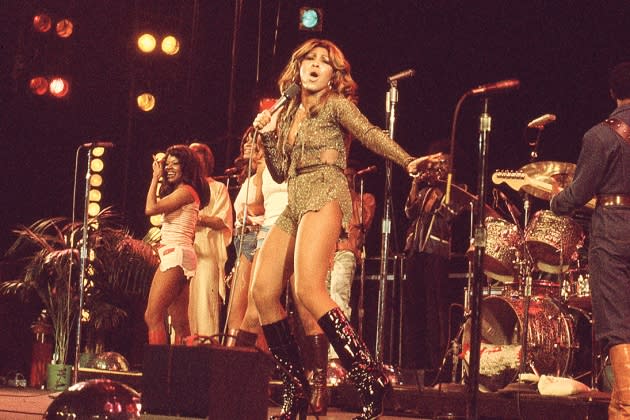Critic’s Appreciation: Tina Turner, Survivor and Supernova
- Oops!Something went wrong.Please try again later.

I’ve been a fan of Tina Turner — the electrifying rock and soul goddess who died Wednesday at 83 after several lifetimes’ worth of legendary performances — for as long as I can remember. Probably since “Nutbush City Limits” hit the airwaves when I was a kid and those swaggering guitar riffs and Moog synthesizer sirens sunk into my bones.
I still can’t hear that song, or other early classics I discovered later, like the volcanic “River Deep — Mountain High,” or Turner’s cover of the Creedence Clearwater Revival hit “Proud Mary,” with its teasing slow start and Richter scale-busting explosion into hyper-speed frenzy, without wanting to drop everything and dance.
More from The Hollywood Reporter
But I only ever saw her once in concert.
That was at London’s Wembley Arena in June 1987, a month after the U.K. paperback release of her autobiography, I, Tina, written with Kurt Loder. A friend in marketing at Penguin Books who had worked on the launch of the memoir snagged tickets for the press box. Did I want to be her plus-one? Just try to stop me.
I had seen Turner’s seismic stage entrances during the Ike & Tina Turner Revue days on TV specials and video clips over the years — the dynamic strut that switched gears into wild, ecstatic movement as the Ikettes fanned out behind her, with funky-chicken arms flapping and legs getting a workout so accelerated they seemed motorized. The shimmy of those beaded fringe minidresses on Tina and her backup trio was hypnotic to a gay boy with an eye for glitter.
Her entrance at Wembley, however, was something else entirely. Our seats were to the left of the stage, so we had a perfect view not just of the performance space, but the long side corridor that led to it from the artists’ backstage area.
I can’t say I remember what song Turner opened with (online research says “What You Get Is What You See”). But I never forgot the bizarre spectacle of two burly men carrying what was clearly an upright body wrapped in some kind of blanket, which they hoisted up the short flight of stairs and then unfurled in a single brisk movement.
Turner, who was pushing 50 at the time, sprang out of that cocoon like something jet-propelled and possessed, limbs energized as if by superhuman force, the signature lion mane of the time flying like a fiber-optic mood lamp in a tornado as she let loose that vocal growl to the roar of 12,500 worshipful fans.
The show, of course, was amazing. She mixed up classics with hits from her renaissance, which started with the gorgeous Al Green cover “Let’s Stay Together” and went on through “Private Dancer,” “Better Be Good to Me,” “What’s Love Got to Do With It,” “I Can’t Stand the Rain” and a fierce take on Robert Palmer’s “Addicted to Love.”
The concert took me back to seeing Turner more than a decade earlier in Ken Russell’s batshit-crazy brilliant film of The Who’s rock opera, Tommy. Playing the Acid Queen and tearing into the song that bears that character’s name, Turner was both scary and seductive.
Only a director with Russell’s taste for excess could have tapped into the performer’s ferociousness to such mesmerizing effect. She drags poor Roger Daltrey up a flight of stairs to her seedy boudoir and then morphs into a suit of futuristic armor equipped with multiple syringes that pump him full of drugs. This is who his parents pay to cure Tommy’s ills?
Her extended cameo in that pop-art extravaganza either temporarily cured Turner of the acting bug or suggested she might be too big for the screen. It was 10 years before she took on another movie role, outside of appearing as herself in concert docs. That was the hilariously named Aunty Entity, founder and ruler of the desert trading post known as Bartertown, and wearer of much chainmail and tribal bling. The film was Mad Max Beyond Thunderdome, the third installment in the Australian post-apocalyptic saga.
While Thunderdome is the most polarizing film of George Miller’s ongoing dystopian series, critics generally agreed that Turner was a powerful presence, a ruthless glamazon in command of her very own gladiatorial arena, but also a woman whose complexity — and let’s face it, a hint of campiness — makes her an atypical villain. The movie also yielded a monster hit for the singer in “We Don’t Need Another Hero.”
Turner’s own life — in particular the turbulent years of her marriage to the violently abusive Ike — was depicted in the 1993 biopic What’s Love Got to Do With It. While Turner later objected to the portrayal of her as a victim and the script’s inaccuracies drew criticism, none of that diminished the emotionally raw performance of Angela Bassett as Tina, earning her a best actress Oscar nomination. (She lost to Holly Hunter in The Piano.)
The life story of Turner and her reinvention as a rock superstar was also the subject of the recent Broadway musical she helped produce, Tina, which won a Tony Award for the sensational Adrienne Warren in the title role. And Turner was given deluxe biographical treatment in HBO’s archive-rich 2021 inspirational legacy doc, called — what else? — Tina.
Given that she rejected the “victim” label, it seems more fitting to call Turner a survivor, a triumphant phoenix who rose from the ashes, propelled only by her own resilience and self-determination. She was a generation-spanning wonder woman, a supernova like no other.
Best of The Hollywood Reporter

